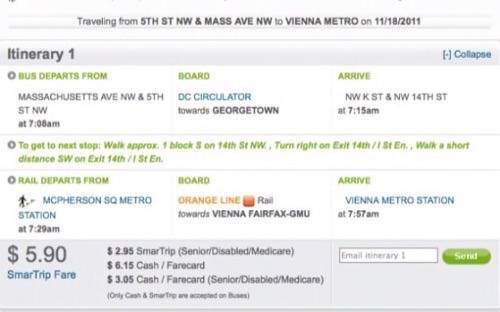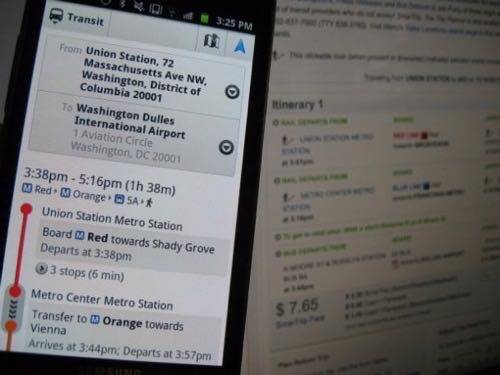Three years ago, the Washington Metropolitan Area Transit Authority looked lost, and so did many of its riders.

Those who hadn’t memorized Metro’s schedules had to employ its persnickety Trip Planner, a clunky Web form that not only won’t let you click on a map to specify your location but also chokes on cities, states, Zip codes and even commas if you add them to a street address. Meanwhile, other U.S. cities had enjoyed transit directions from sites like Google Maps since at least 2005. But not DC.
Worse yet, after the first step to share schedules, converting data to the standard General Transit Feed Specification format, Metro had halted the effort. In December 2008, a spokesman told the urban-development blog Greater Greater Washington that continuing it was “not in our best interest from a business perspective.” That left Metro riders with kludgey, screen-scraping workarounds like DCist’s text-messaging service.
But now, Metro rail and bus directions are clicks or taps away in third-party sites and applications, allowing passengers to benefit from such innovations as Google’s stop-by-stop transit navigation on Android phones. The changes in between suggest a road map for other organizations having their own open-data debates.

Start lobbying to open a conversation. Greater Greater Washington editor David Alpert quickly had hundreds of signatures on a petition protesting the decision. That persuaded Metro to detail its objections: fear of losing $68,000 in yearly ad revenue from the Trip Planner page, a wish to be paid for its data, and the legalese around data sharing. That then widened the discussion from an argument over APIs to one over the proper use of taxpayer dollars.
“David came along and started this campaign,” said Christopher Zimmerman, an Arlington County Board member who chaired Metro’s board in 2008. “It wouldn’t have happened without the public pressure.” Alpert could also lobby Metro from closer in after joining its Riders’ Advisory Council in January of 2009.
Rob Pegoraro worked for more than a decade covering technology for the Washington Post. His blog can be found here.
Flipping the debate from potential profits to actual expenses. Gordon Linton, a former head of the Federal Transit Administration who served alongside Zimmerman on the Metro board, focused on the opportunity cost of giving data to other sites. He said the agency had given away resources – for example, free parking for car-sharing services – that it later realized could yield income.
“While we were raising fares and cutting service if we were investing staff time and energy for a product that would reap some financial benefit for those who would use it and sell it, then we in turn should get some money back,” Linton said.
Zimmerman took the opposite argument: the ease of upgrading one aspect of the Metro experience. “We were having a lot of difficulties,” he said. “If some of these things don’t cost us anything or don’t cost us a lot [to fix], we should do them right away.”
Alpert suggested this debate encouraged Metro staffers to rethink things. “Staff may have felt they were under orders from the board to maximize revenue. Zimmerman gave them permission not to worry about that.”

Oh, and Google never had any interest in paying for a schedule feed. Wrote spokeswoman Anne Espiritu: “We do not pay agencies for their data.”
A change in leadership can help. All of this effort got sidetracked on June 22, 2009 when two Red Line trains collided and killed nine passengers. Things were set back further when general manager John Catoe unexpectedly resigned in early 2010 and his interim replacement Richard Sarles had to focus on safety upgrades.
But Sarles’ earlier employer, NJ Transit, had provided rail schedules to Google back in 2008. He wanted to follow suit here, said Metro spokesman Dan Stessel.
Metro and Google signed a data-sharing agreement in July of 2010, once Google had dropped earlier demands for an indemnification clause. Metro directions showed up on Microsoft’s Bing Maps in September 2010; they arrived on Google in May after a final shove from Sarles following his appointment as WMATA’s full-time general manager in January.
(But even now, you must return to Metro’s sites or a few third-party apps for bus and train arrival predictions. Google only announced a standard format for that data, GTFS-realtime, in August, and Metro is still weighing support for that. And some regional bus systems that Metro’s Trip Planner includes have yet to provide their own GTFS data to mapping sites.)
What about the original financial arguments? We may never know how the math worked out: without detailed surveys, you can’t draw a line from clicking on maps to boarding trains. But Stessel, who didn’t provide a dollar cost for the work involved, suggested that the rationale merchants invoke to invest in intangibles like store or site designs works for public transit too: “Our primary motivation is improving the customer experience.” Zimmerman had a more philosophical justification for how a government agency should act: “Putting information in the public domain is part of what we do.”
Sometimes, being open isn’t easy. You could say that there were many stops on the route that Metro took.

















